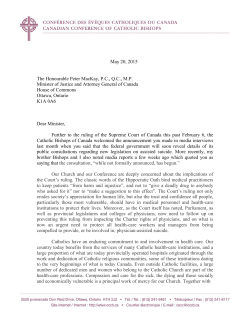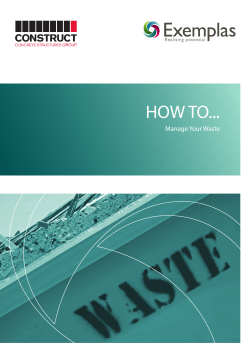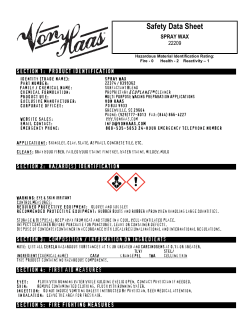
Biomedical Waste Management - Nispana | Innovative Platforms
Best Practices in Biomedical Waste Management Deepinder Singh, Head – Quality Improvement KIMS Group of Hospitals Oman I UAE I KSA I Bahrain I Qatar I India PROBLEMS Definition Biomedical waste Any waste which is generated during the diagnosis, treatment or immunization of human beings or animals or in research activities SOURCES • • • • • • • Major Sources Hospitals Medical Centers Related laboratories and research centres Biotechnology institutions Mortuary and autopsy centres Animal research and testing Blood banks and blood collection services • • • • • Minor Sources Physicians/ dentists’ clinics Animal houses/slaughter houses. Blood donation camps. Vaccination centers. Funeral services. CLASSIFICATION The World Health Organization, 2014 (WHO) TYPICAL WASTE COMPOSITIONS IN HEALTH-CARE FACILITIES World Health Organization states that 85% of hospital wastes are actually non-hazardous, whereas 10% are infectious and 5% are noninfectious but they are included in hazardous wastes. About 15% to 35% of Hospital waste is regulated as infectious waste. Safe management of wastes from health-care activities (WHO), 2014 WASTE GENERATION IN DEVELOPING COUNTRIES WASTE GENERATION IN A DEVELOPED COUNTRY CHARACTERISTICS OF HAZARDS The hazardous nature of health-care waste is due to one or more of the following characteristics: • Presence of infectious agents • A genotoxic or cytotoxic chemical composition • Presence of toxic or hazardous chemicals or biologically aggressive pharmaceuticals • Presence of radioactivity • Presence of used sharps PROBLEMS WITH IMPROPER BIOMEDICAL WASTE DISPOSAL Injuries from sharps leading to infection to all categories of hospital personnel and waste handler. Nosocomial infections in patients from poor infection control practices and poor waste management. Risk of infection outside hospital for waste handlers and scavengers and at time general public living in the vicinity of hospitals. Risk associated with hazardous chemicals, drugs to persons handling wastes at all levels. “Disposable” being repacked and sold by unscrupulous elements without even being washed. Drugs which have been disposed of, being repacked and sold off to unsuspecting buyers. Risk of air, water and soil pollution directly due to waste, or due to defective incineration emissions and ash HAZARDS FROM INFECTIOUS WASTE AND SHARPS WHO IS AT RISK ? Medical doctors, nurses, health-care auxiliaries and hospital maintenance personnel Patients in health-care facilities or receiving home care Visitors to health-care facilities Workers in support services, such as cleaners, people who work in laundries, porters Workers transporting waste to a treatment or disposal facility Workers in waste-management facilities (such as landfills or treatment plants), as well as informal recyclers The general public could also be at risk whenever hazardous healthcare waste is abandoned or disposed of improperly. SOLUTIONS BIOMEDICAL WASTE DISPOSAL Segregation Containment Labelling Collection Handling Thermal Processes Chemical Processes Irradiation technologies Transport Storage Disposal Records Biological processes Mechanical processes THE WASTE-MANAGEMENT HIERARCHY RECYCLING AND RECOVERY Recycling is increasingly popular in some health-care facilities, especially for the large, non-hazardous portion of waste. It can reduce costs considerably, either through reduced disposal costs or through payments made by a recycling company for the recovered materials National Health Service (NHS) Foundation Trust facility in the United Kingdom generates the annual waste equivalent of 5500 households. The trust invested in balers and compactors to facilitate waste recycling, particularly paper and cardboard Health Care Foundation – Nepal recycles bloodcontaminated plastics after autoclaving. The foundation also recycles paper, plastic and glass, and estimates that 40% of waste-handling costs are covered by recycling. SAFE REUSE The use of non-disposable items for medical procedures should be encouraged where their reuse after cleaning can be demonstrated to minimize infection transmission to acceptably low probabilities • Endoscopes • Surgical instruments WASTE MINIMIZATION The most preferable approach, if locally achievable, is to avoid producing waste as far as possible and thus minimize the quantity entering the waste stream. Where practicable, recovering waste items for secondary use is the next most preferable method. Waste that cannot be recovered must then be dealt with by the least preferable options, such as treatment or land disposal, to reduce its health and environmental impacts. WASTE MINIMIZATION Source reduction • Purchasing reductions: selecting supplies that are less wasteful where smaller quantities can be used, or that produce a less hazardous waste product. • Use of physical rather than chemical cleaning methods (e.g. steam disinfection instead of chemical disinfection). • Prevention of wastage of products (e.g. in nursing and cleaning activities). Management and control measures at hospital level • Centralized purchasing of hazardous chemicals. • Monitoring of chemical use within the health center from delivery to disposal as hazardous wastes. Stock management of chemical and pharmaceutical products • More frequent ordering of relatively small quantities rather than large amounts at one time, to reduce the quantities used (applicable in particular to unstable products). • Use of the oldest batch of a product first. • Use of all the contents of each container. • Checking of the expiry date of all products at the time of delivery, and refusal to accept short-dated items from a supplier. ENVIRONMENTALLY PREFERABLE PURCHASING (EPP) Purchase of the least damaging products and services, in terms of environmental impact Conserve energy and water Increase the use of recycled and reused materials Reduce hazardous substances, especially persistent, bioaccumulative and toxic chemicals Decrease greenhouse gas emissions Improve indoor air quality Promote end-of-life management Reduce waste http://www.nyc.gov/html/mocs/html/programs/epp.shtml GREEN PROCUREMENT • Reducing the toxicity of waste is also beneficial, by reducing the problems associated with its treatment or disposal • Globally, the most easily recyclable plastics are polyethylene, polypropylene and polyethylene terephthalate (PET). Conversely, polyvinyl chloride (PVC) is the most difficult, partly because its products come in a variety of forms containing different additives. • Packaging of mixed materials, such as paper or card covered in plastic or aluminum foil, is rarely recyclable. • Ethylene oxide is used to sterilize medical devices, but it is carcinogenic and so should be avoided where alternatives exist. ENVIRONMENTAL MANAGEMENT SYSTEMS • An environmental management system (EMS) is a formal approach in countries with strict environmental laws to manage an organization’s impact on the environment. • Hospitals and health centres of any size should derive a benefit from introducing and implementing an EMS. These benefits include cost reductions through – – – – Reduced energy consumption Reduced quantities of waste Increased recycling Minimized negative impacts on the environment from waste handling and treatment – An improved public image. • An environmental procurement policy in a Hospital under NHS, UK, reduced health-care waste quantities by 4.1% (78 tonnes), energy consumption by 3.6% and water usage by 9.6% LEGISLATIVE, REGULATORY AND POLICY ASPECTS OF HEALTH-CARE WASTE Guiding principles 1. 2. 3. 4. 5. The “polluter pays” principle The “precautionary” principle The “duty of care” principle The “proximity” principle The “prior informed consent” principle INTERNATIONAL AGREEMENTS AND CONVENTIONS • • • • • The Basel Convention The Bamako Convention The Stockholm Convention The environment and sustainable development conferences United Nations Committee of Experts on the Transport of Dangerous Goods • United Nations Economic Commission for Europe • Aarhus Convention of the United Nations Economic Commission for Europe SHORT-TERM STRATEGIES 1. 2. 3. 4. 5. Production of all syringe components using the same plastic to facilitate recycling. Selection of polyvinyl chloride–free medical devices. Identification and development of recycling options wherever possible (e.g. for plastic, glass). Research into, and promotion of, new technology or alternative to smallscale incineration. Until countries in transition and developing countries have access to health-care waste-management options that are safer for the environment and health, incineration may be an acceptable response when used appropriately. Key elements of appropriate operation of incinerators include effective waste reduction and waste segregation, placing incinerators away from populated areas, satisfactory engineered design, construction following appropriate dimensional plans, proper operation, periodic maintenance, and staff training and management. MEDIUM-TERM STRATEGIES 1. Further efforts to reduce the number of unnecessary injections, to reduce the amount of hazardous healthcare waste that needs to be treated. 2. Research into the health effects of chronic exposure to low levels of dioxin and furan. 3. Risk assessment to compare the health risks associated with (a) incineration, and (b) exposure to health-care waste. LONG-TERM STRATEGIES 1. 2. 3. 4. 5. Effective, scaled-up promotion of non-incineration technologies for the final disposal of health-care waste to prevent the disease burden from (a) unsafe health-care waste management, and (b) exposure to dioxins and furans. Support to countries in developing a national guidance manual for sound management of health-care waste. Support to countries in developing and implementing a national plan, policies and legislation on health-care waste. Promotion of the principles of environmentally sound management of health-care waste as set out in the Basel Convention. Support to allocate human and financial resources to safely manage health-care waste in countries. Collaboration RESPONSIBILITIES : GOVERNMENTS • Allocate a budget to cover the costs of establishment and maintenance of sound health-care waste management systems • Request donors, partners and other sources of external financing to include an adequate contribution towards the management of waste associated with their interventions; • Implement and monitor sound health-care waste management systems, support capacity building, and ensure worker and community health. RESPONSIBILITIES OF OTHERS NGOs should • Include the promotion of sound health-care waste management in their advocacy • Undertake programs and activities that contribute to sound health-care waste management. The private sector should • Take responsibility for the sound management of health-care waste associated with the products and services it provides, including the design of products and packaging. All concerned institutions and organizations should • Promote sound health-care waste management • Develop innovative solutions to reduce the volume and toxicity of the waste they produce and that is associated with their products • Ensure that global health strategies and programs take into account health-care waste management. NATIONAL LEGISLATION : ELEMENTS TO BE CONSIDERED A clear definition of hazardous health-care waste and its various categories A precise indication of the legal obligations of the health-care waste producer regarding safe handling and disposal Specifications for record keeping and reporting Establishment of permit or licensing procedures for systems of treatment and waste handling Specifications for an inspection system and regular audit procedures to ensure enforcement of the law and for penalties to be imposed for contravention Designation of courts responsible for handling disputes arising from enforcement of, or non-compliance with, the law MINIMUM APPROACH TO DEVELOPING HEALTH-CARE WASTE-MANAGEMENT POLICY Where there is no national policy, legislation or guidelines, this should not prevent a hospital or health-care facility from commencing a modest program of health-care waste management. A short document could be prepared that states the problems, sets out simple actions, identifies the stakeholders, and mobilizes them to carry out the actions. The following two example publications can be downloaded from the internet: 1. Starting health care waste management in medical institutions (WHO, 2000), available at http://www.healthcarewaste.org/fileadmin/user_upload/resources/HCW_practicalInfo1.pdf 2. Preparation of national health care waste management plans in sub-Saharan countries: guidance manual (WHO, 2005), available at http://www.who.int/water_sanitation_health/medicalwaste/guidmanual/en/ The success of a practical health-care waste-management plan in one hospital will often influence other hospitals. It may also encourage national governments subsequently to devise the necessary national policy and framework. CONCLUSIONS Actions involved in implementing effective health-care waste management programs require multisectoral cooperation and interaction at all levels. Establishment of a national policy and a legal framework, training of personnel, and raising public awareness are essential elements of successful health-care waste management. Improved public awareness of the problem is vital in encouraging community participation in generating and implementing policies and programs. Hospitals are meant only to cure diseases. Deepinder Singh Head – Quality Improvement KIMS Group of Hospitals Oman I UAE I KSA I Bahrain I Qatar I India deepinder@live.in
© Copyright 2025









